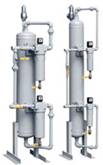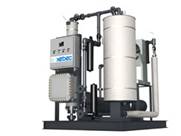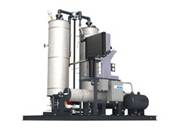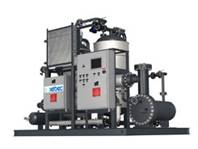“The single most important safety requirement of compressed natural gas (CNG) fuel, according to ISO 15403:2000 (E) (paragraph 5.1), is a very low water dew point temperature to preclude the formation of liquid water at any time. Liquid water is the precursor to the formation of corrosive compounds through combination with components in natural gas, namely carbon dioxide and hydrogen sulfide. The combination of corrosive agents, and the pressure cycling, caused by fuel consumption and subsequent refilling of the fuel storage container, can result in crack growth in metals and ultimately damage and failure. Also liquid water itself can be detrimental as it may cause blockages, both liquid and solid, in the fuel system.”
The most common reason for not installing dryers in CNG Fueling Stations is the belief that the natural gas is already dry. However, it should be taken into consideration that although the natural gas dew point may be as low as -40°C in the pipeline at pipe pressure, the effects of compression will affect the dew point of the natural gas.
Physical laws dictate that the dew point of a gas increases as its pressure increases. Therefore, although the dew point of the natural gas in a given pipeline may be very low when it reaches the compressor, it will be significantly higher when the natural gas leaves the compressor. This is why natural gas desiccant dryers are required in the majority of CNG Fueling Stations in order to conform to the ISO 15403:2000(E) standard, specifically in areas where lower temperatures are encountered during the colder winter months.
Single Tower Natural Gas Dryer
 Features:
Features:
- Low cost, low capacity basic package
- External regeneration or desiccant replacement required
- AutoDew is a highly recommended option
Applications:
- Low to medium flows
- Low to high pressure design
- Recommended for low throughput (water content) fueling needs
Regenerable Single Tower Natural Gas Dryer
 Features:
Features:
- Comprehensive range of rugged, skid mounted single and dual tower regenerable natural gas dryers
- Closed loop, operator initiated heat reactivated regenerated cycles for reliable dryer regeneration control and shutdown
- AutoDew is a standard feature and will signal when regeneration is required
Applications:
- Medium to high flows
- Low to high pressure design
- Recommended for medium throughput fueling needs
- Minimum downtime (no downtime required for duplex model)
Regenerable Twin Tower Natural Gas Dryer
 Features:
Features:
- Twin tower
- Economic simplified four-way valve design
- Compact design
- All models complete with regeneration package
- AutoDew as standard feature
- Limited in pressure and flow capacity
- Available in automatic and manual versions
- Integrated or remote control panel available
Applications:
- Low to medium flows
- Low to medium pressure design
- Recommended for medium throughput fueling needs
- No downtime
Fully Automatic Heat Reactivated Twin Tower
 Features:
Features:
- Designed and engineered for large flow and continuous duty cycles
- Fully automatic and maximized desiccant regeneration, dew point performance and energy efficiency
- Large LCD text display shows dryer status and alarms at all times
- Custom designed to meet all levels of specifications
Applications:
- Medium to high flows
- Low to high pressure design
- Recommended for medium to high throughput fueling needs
- No downtime
